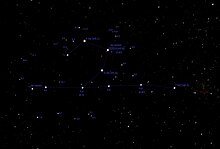| Observation data Epoch J2000.0 Equinox J2000.0 | |
|---|---|
| Constellation | Vulpecula |
| Right ascension | 19 29 20.8974 |
| Declination | 20° 16′ 47.0583″ |
| Apparent magnitude (V) | 6.337 |
| Characteristics | |
| Spectral type | B4–5 III–IVe |
| U−B color index | −0.585 |
| B−V color index | −0.157 |
| Astrometry | |
| Radial velocity (Rv) | −38.0±4.3 km/s |
| Proper motion (μ) | RA: 2.555±0.069 mas/yr Dec.: −15.383±0.071 mas/yr |
| Parallax (π) | 3.5826 ± 0.04 mas |
| Distance | 910 ± 10 ly (279 ± 3 pc) |
| Absolute magnitude (MV) | −1.66+0.44 −0.51 |
| Orbit | |
| Period (P) | 69.30±0.07 d |
| Eccentricity (e) | 0.161±0.035 |
| Periastron epoch (T) | 2,454,248.1±2.7 HJD |
| Argument of periastron (ω) (secondary) | 247±16° |
| Semi-amplitude (K1) (primary) | 8.9±0.4 km/s |
| Details | |
| 7 Vul A | |
| Mass | 5.5±0.5 M☉ |
| Radius | 5.2 R☉ |
| Surface gravity (log g) | 3.75±0.02 cgs |
| Temperature | 15,600±200 K |
| Rotational velocity (v sin i) | 300±30 km/s |
| Age | 50–80 Myr |
| 7 Vul B | |
| Mass | 0.50 – 0.77 M☉ |
| Other designations | |
| 7 Vul, BD+19 4039, HD 183537, HIP 95818, HR 7409, SAO 87269 | |
| Database references | |
| SIMBAD | data |

7 Vulpeculae is a binary star system approximately 910 light years away in the slightly northern constellation of Vulpecula. It is a challenge to view with the naked eye, having an apparent visual magnitude of 6.3. The system currently has a heliocentric radial velocity of −38 km/s.
This is a single-lined spectroscopic binary star system with an orbital period of 69.3 days and an eccentricity of 0.16. The visible component is a Be star with a stellar classification of B4–5 III–IVe that appears to be nearing the end of its main sequence lifetime. The system shows a rapid projected rotational velocity of 300 km/s, which is just below the estimated critical velocity for a binary of 367 km/s.
There is a small variability in the magnitude over a 0.559-day cycle; this is likely the rotation period of the primary star.
The nature of the companion is unknown, but based upon its mass it may be a K- or M-type star. It could be a white dwarf that has undergone a mass transfer to the primary. Because of the lack of X-ray emission from the system, a third possibility is that the companion is a naked He star that has been stripped of its hydrogen envelope.
References
- ^ Brown, A. G. A.; et al. (Gaia collaboration) (August 2018). "Gaia Data Release 2: Summary of the contents and survey properties". Astronomy & Astrophysics. 616. A1. arXiv:1804.09365. Bibcode:2018A&A...616A...1G. doi:10.1051/0004-6361/201833051. Gaia DR2 record for this source at VizieR.
- ^ Harmanec, P.; et al. (2020). "A new study of the spectroscopic binary 7 Vul with a Be star primary". Astronomy and Astrophysics. 639. Table A.1. arXiv:2005.11089. Bibcode:2020A&A...639A..32H. doi:10.1051/0004-6361/202037964. S2CID 218862853.
- ^ Vennes, S.; et al. (2011). "On the nature of the Be star HR 7409 (7 Vul)". Monthly Notices of the Royal Astronomical Society. 413 (4): 2760–2766. arXiv:1101.2622. Bibcode:2011MNRAS.413.2760V. doi:10.1111/j.1365-2966.2011.18350.x. S2CID 118519164.
- ^ Anderson, E.; Francis, Ch. (2012). "XHIP: An extended hipparcos compilation". Astronomy Letters. 38 (5): 331. arXiv:1108.4971. Bibcode:2012AstL...38..331A. doi:10.1134/S1063773712050015. S2CID 119257644.
- ^ Vallenari, A.; et al. (Gaia collaboration) (2023). "Gaia Data Release 3. Summary of the content and survey properties". Astronomy and Astrophysics. 674: A1. arXiv:2208.00211. Bibcode:2023A&A...674A...1G. doi:10.1051/0004-6361/202243940. S2CID 244398875. Gaia DR3 record for this source at VizieR.
- ^ "7 Vul". SIMBAD. Centre de données astronomiques de Strasbourg. Retrieved 28 August 2012.
External links
- 7 Vulpeculae on WikiSky: DSS2, SDSS, GALEX, IRAS, Hydrogen α, X-Ray, Astrophoto, Sky Map, Articles and images
| Constellation of Vulpecula | |||||||||||||
|---|---|---|---|---|---|---|---|---|---|---|---|---|---|
| Stars |
| ||||||||||||
| |||||||||||||
| |||||||||||||
| |||||||||||||
| Galaxies |
| ||||||||||||
| |||||||||||||